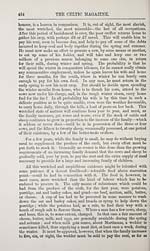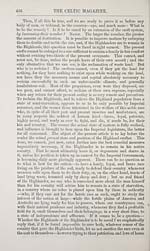Blair Collection > Celtic magazine > Volume 2
(465)
Download files
Complete book:
Individual page:
Thumbnail gallery: Grid view | List view

THE CELTIC MAGAZINE.
455
it goes, and tlic necessary supply of meal over and above the produce of
the croft.
It must now be clear tliat. althougli a good many of this class may be
met with in the more favourable circumstances descril)cd, no sooner do
they get into the comparatively more affluent position, in consequence of
their children having grown nj), and aided them, than, by the breaking
up of the family — when the sons and daughters begin to look out for
themselves — the crofter, in his latter days, begins to gravitate to his old
poverty and wretchedness, and, nuless one of the family stays Avith and
provides for him in his old age, the poor-roll, which he instinctively
abominates, is his only hope.
"\Ye have hitherto been considering the question on the assumption
that neither death nor affliction had visited the household ; but as these
will inevitably visit sometimes the most fortunate, a few more degrees of
intensity must be added to the sufficiently miserable state of matters
already depicted.
It is qnite possible that some of those imaginative theorists may say
that we are over-stating the wretchedness of the Highland crofter. The
very opposite, however, is the case. It is impossible to over-state it, or
give a proper idea of its extreme wretchedness on paper, especially in the
space {it present at onr disposal The actual misery endured by the great
majority of these poor and helpless creatures is inconceivable. We have
known scores of cases where^ durmg the summer months, after the old
crop had been exhausted, and the new one had not yet become available,
where the family lived mainly on periwinkles, mussels, and barnacles,
gathered on the sea shore ; others, not quite so wretched, but so severely
pinched that the family lived for Aveeks on a small quantity of milk
curdled -with a little reimet, to make it appear, in the eyes of the children,
a little more substantial. This does not refer merely to special periods of
destitution, like those so well described in recent numbers by the Rev.
Alexander Macgi'egor. This wi'etchedness has been for many years, and
still is, quite common in the Highlands, which may be said, although
some periods have been more drastic than others, to be in a chronic state
of destitution, and it will naturally be getting worse while the population*
continues to increase in the districts wliere crofts prevail.
* It will be seen by the following figures that, instead of diminishing, as many
writers maintain, the population in most of the croft districts has enormously increased
during tho present century— doubling, trebling, and in some cases almost quadrupling.
The figures in the cases of Lochalsti, Lochcarron, and Lochbroom are not so complete as
we should like to have them for the purposes of a contrast with the beginning of the
century, had we the necessary material within reach : —
455
it goes, and tlic necessary supply of meal over and above the produce of
the croft.
It must now be clear tliat. althougli a good many of this class may be
met with in the more favourable circumstances descril)cd, no sooner do
they get into the comparatively more affluent position, in consequence of
their children having grown nj), and aided them, than, by the breaking
up of the family — when the sons and daughters begin to look out for
themselves — the crofter, in his latter days, begins to gravitate to his old
poverty and wretchedness, and, nuless one of the family stays Avith and
provides for him in his old age, the poor-roll, which he instinctively
abominates, is his only hope.
"\Ye have hitherto been considering the question on the assumption
that neither death nor affliction had visited the household ; but as these
will inevitably visit sometimes the most fortunate, a few more degrees of
intensity must be added to the sufficiently miserable state of matters
already depicted.
It is qnite possible that some of those imaginative theorists may say
that we are over-stating the wretchedness of the Highland crofter. The
very opposite, however, is the case. It is impossible to over-state it, or
give a proper idea of its extreme wretchedness on paper, especially in the
space {it present at onr disposal The actual misery endured by the great
majority of these poor and helpless creatures is inconceivable. We have
known scores of cases where^ durmg the summer months, after the old
crop had been exhausted, and the new one had not yet become available,
where the family lived mainly on periwinkles, mussels, and barnacles,
gathered on the sea shore ; others, not quite so wretched, but so severely
pinched that the family lived for Aveeks on a small quantity of milk
curdled -with a little reimet, to make it appear, in the eyes of the children,
a little more substantial. This does not refer merely to special periods of
destitution, like those so well described in recent numbers by the Rev.
Alexander Macgi'egor. This wi'etchedness has been for many years, and
still is, quite common in the Highlands, which may be said, although
some periods have been more drastic than others, to be in a chronic state
of destitution, and it will naturally be getting worse while the population*
continues to increase in the districts wliere crofts prevail.
* It will be seen by the following figures that, instead of diminishing, as many
writers maintain, the population in most of the croft districts has enormously increased
during tho present century— doubling, trebling, and in some cases almost quadrupling.
The figures in the cases of Lochalsti, Lochcarron, and Lochbroom are not so complete as
we should like to have them for the purposes of a contrast with the beginning of the
century, had we the necessary material within reach : —
Set display mode to: Large image | Transcription
Images and transcriptions on this page, including medium image downloads, may be used under the Creative Commons Attribution 4.0 International Licence unless otherwise stated. ![]()
| Early Gaelic Book Collections > Blair Collection > Celtic magazine > Volume 2 > (465) |
|---|
| Permanent URL | https://digital.nls.uk/78485734 |
|---|
| Description | Volume II, 1877. |
|---|---|
| Shelfmark | Blair.3 |
| Attribution and copyright: |
|
| Description | A selection of books from a collection of more than 500 titles, mostly on religious and literary topics. Also includes some material dealing with other Celtic languages and societies. Collection created towards the end of the 19th century by Lady Evelyn Stewart Murray. |
|---|
| Description | Selected items from five 'Special and Named Printed Collections'. Includes books in Gaelic and other Celtic languages, works about the Gaels, their languages, literature, culture and history. |
|---|

